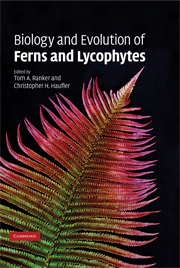Book contents
- Frontmatter
- Contents
- List of contributors
- Preface
- Acknowledgments
- Part I Development and morphogenesis
- Part II Genetics and reproduction
- 4 Population genetics
- 5 Antheridiogens
- 6 Structure and evolution of fern plastid genomes
- 7 Evolution of the nuclear genome of ferns and lycophytes
- Part III Ecology
- Part IV Systematics and evolutionary biology
- Index
- References
4 - Population genetics
Published online by Cambridge University Press: 11 August 2009
- Frontmatter
- Contents
- List of contributors
- Preface
- Acknowledgments
- Part I Development and morphogenesis
- Part II Genetics and reproduction
- 4 Population genetics
- 5 Antheridiogens
- 6 Structure and evolution of fern plastid genomes
- 7 Evolution of the nuclear genome of ferns and lycophytes
- Part III Ecology
- Part IV Systematics and evolutionary biology
- Index
- References
Summary
Introduction
William Henry Lang (1923) and Irma Andersson (later Andersson-Kottö; e.g., Andersson, 1923, 1927; Andersson-Kottö, 1929, 1930, 1931) were pioneers in the field of fern genetics. Lang (1923) was the first to demonstrate simple Mendelian inheritance in a fern with his experimental study of the inheritance of entire versus incised leaf margins in Scolopendrium vulgare. Andersson studied inheritance in ferns and was the first to introduce the use of an agar-based growth medium for the experimental study of fern gametophytes (Andersson, 1923). These pioneers paved the way for future explorations of fern and lycophyte population genetics.
In considering how ferns and lycophytes develop and maintain genetic variation, contemporary investigators have used an array of techniques to explore several primary, intertwining topics such as the population genetic implications of reproductive biology (including genetic load), genetic diversity and structure of populations, gene flow and divergence, and the genetics of dispersal and colonization. The goal of this chapter is to review the fern and lycophyte population genetic literature across these broad categories, to provide a synthesis of current knowledge, and to suggest possible future directions of study. We will focus primarily on homosporous taxa because little population genetic research has been conducted on heterosporous taxa.
Population genetics and reproductive biology
An understanding of the reproductive biology of individuals and populations is fundamental for discussing the genetics of populations.
- Type
- Chapter
- Information
- Biology and Evolution of Ferns and Lycophytes , pp. 107 - 133Publisher: Cambridge University PressPrint publication year: 2008
References
- 20
- Cited by



